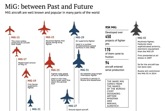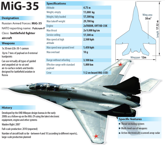Ready to supply MiG-35s to India - Korotkov
How do you assess the current partnership between RSK MiG and India?
In light of the present celebrations, it is worth noting that the successful partnership between RSK MiG and India was laid down 50 years ago, when the then leaders of our countries, Jawaharlal Nehru and Nikita Khrushchev, took steps to promote friendship between the Indian and Soviet peoples. The 1962 agreement on the supply of MiG-21 planes, and the subsequent contract for the production of fighters by Hindustan Aeronautics Limited (HAL) under license to the USSR, is the foundation on which we are now able to implement other projects in the spirit of fruitful cooperation. We do not just sell aviation equipment, but also transfer technologies to develop production in India, namely industrial centres and repair facilities. This has not gone unnoticed, and it benefits not only bilateral relations, but Russian-Indian military-technical cooperation in general. In view of the scale of the work we are carrying out, it is safe to say that the above-mentioned success will be continued and built upon.
Are Indian pilots being trained to operate MiG-29K/KUB aircraft for the Vikramaditya carrier?
On Saturday, April 20, a contract was signed between the Indian Ministry of Defence (MoD) and RSK MiG according to which we are to train Indian pilots to fly the MiG-29K/KUB. It consists of two stages. The first is set to commence in Russia ten weeks before the Vikramaditya is handed over to the Indian Navy this year. Training in accordance with the very latest standards and requirements will continue in India. In addition, RSK MiG is helping to build a training ground in India to instruct pilots in operating carrier-based aircraft. The preparatory course will run for ten weeks.
How many MiG-29K/KUB planes have been supplied for the Vikramaditya under the second contract?
The basic contract for the delivery of 16 MiG-29K/KUBs was successfully fulfilled. They are all based in India now. Last year, a further four aircraft were delivered under the second (option) contract. This year will see Russia deliver the next batch of four aircraft as per its contractual obligations.
RSK MiG has supplied the first three of 63 modernized MiG-29 fighters to the IAF. How is the upgrade going?
The contract consists of two parts: the delivery of modernized aircraft to India and the supply of component kits to upgrade them domestically. Three aircraft, as you correctly stated, have already been delivered, and three more are due to be delivered this year. Component kits have also been supplied. We cannot disclose the cost of the upgrade, but it will end up far cheaper than modernizing the Mirage-2000, for example, especially for India, our trusted friend and partner.
Since 1971, the IAF has lost 482 MiG planes. Although the present discussions in India do not favour Russian fighters, most former pilots vouch for their reliability. Have you met with representatives of the Indian MoD to discuss the causes of the accidents?
Russia and India set up a working group comprising experts from both countries. They discussed the problems and drew conclusions, thanks to which, since 2004, the number of in-flight incidents and actual accidents has fallen sharply. The machine was engineered over many years, and numerous pilots have experience of it. That formed the basis of the findings. It also needs to be understood that the aircraft operating conditions in Russia and India are very different.
When do you plan to sign a contract with the Russian MoD for delivery of the MiG-35?
The negotiations are at an advanced stage. We expect them to conclude this year with the signing of a contract. A MiG-35 prototype is already airborne. As for exact dates, we hope to sign a contract in the first half of 2013.
When will delivery begin of 24 MiG-29K/KUBs for the Russian MoD?
A supply contract was signed in February 2012, and the first planes will be delivered this year for testing.
Related:
India celebrates ‘Golden Jubilee’ of MiG-21’s association with the IAF
Russia continues to supply cutting-edge technology to India - Alexander Kadakin
Will the new MiG fighters for the Russian Air Force include components made in other countries? For example, the MiG-29SMT currently in service features the Sigma inertial navigation system, manufactured by France's SAGEM.
Probably. For the first time, the Russian MoD has decided to allow the use of foreign components in procured aircraft, in particular navigation and helmet-mounted targeting systems.
Where did the Russian pilots practice their carrier takeoff and landing skills when testing the Indian MiG-29K/KUB fighters for the Vikramaditya, since the NITKA training ground at the Saki aerodrome in the Crimea is not presently operational?
Russian pilots are used to flying carrier-based fighters. The USSR also had a long history, and the experience gained by Soviet pilots was passed on to the new generation of Russian pilots. RSK MiG has developed special training techniques, which we use to train young pilots. They were employed in landing aircraft on board the Vikramaditya. We are able to instruct pilots without NITKA, or any other training ground.
What expectations do you place on future cooperation between RSK MiG and India?
Our expectations are primarily related to the MiG-35. Despite conceding the tender to supply the IAF with 126 multirole fighters, RSK MIG fulfilled all the requirements put forward by the tender committee. The aircraft demonstrated good results, occasionally surpassing expectations. As part of the knowhow that India picked up in the course of the tender, I would like to see the MiG-35 continue to feature against the backdrop of our shared history and 50-year partnership. We expect India to consider the option of concluding a contract for the supply of the MiG-35, and we will be able to fulfil it.
Sergei Korotkov lands MiG-29K on INS Vikramaditya
How is the joint development of an unmanned aerial vehicle (UAV) between RSK MIG and Sukhoi progressing?
The project to develop a Russian-made combat UAV has been ongoing for some time now. We used our combined groundwork to identify the scope and skill set of both companies. RSK MiG is already far advanced in the development of an in-house UAV, the Scat. We have taken a lot of positives from this project.
Is RSK MiG planning to participate in the programme to supply Russian arms to Bangladesh?
RSK MiG was one of the architects of this project. We are actively working to conclude a contract with Bangladesh to modernise eight MiG-29s currently in operation there, and look forward to the Bangladeshi side making the right decision, i.e. agreeing to our proposal. It would make sense for them from an economic perspective. The fact is we always say ‘aircraft,’ but I would prefer in this case ‘aeronautical complex,’ which includes maintenance and training. It's all written into the contract and is one of the selling points.
JSC United Aircraft Corporation (UAC) president Mikhail Pogosyan said that RSK MiG could get involved in transport aircraft programs. What is the subject of the talks between UAC and RSK MiG, and how might MiG play a role?
We are already in collaboration with Ilyushin Corporation, which is involved in the development of a multi-purpose transport aircraft for India, and other such projects. RSK MiG contributed to the design documentation, and intends to continue its involvement in the project.
All rights reserved by Rossiyskaya Gazeta.

